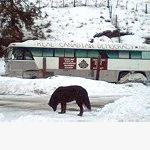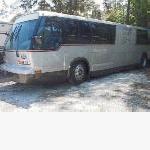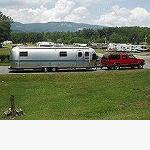| Author | Message | ||
| FAST FRED (Fast_fred)
Registered Member Username: Fast_fred Post Number: 940 Registered: 10-2006 Posted From: 76.202.165.190  Rating: N/A |
I am still attempting to figure the "best" rear ratio for our project bus. So the question is, at 50 mph,60 mph and 70 mph how much HP is required to climb a 6% grade for each 10,000lbs? This info is needed regardless of the wind resistance , which will also vary with the speed (and each coach). What I'm trying to figure out is both how high a gear I can pull , as well as what will happen with a 10,000 trailer in tow. I think this was covered in really early BC , but I passed my day one collection on. FF | ||
| clint hunter (Truthhunter)
Registered Member Username: Truthhunter Post Number: 471 Registered: 1-2009 Posted From: 24.129.232.219  Rating: N/A |
all three engine manufactures had a power to weight gear calculator on there sites a few years back, you might surf there , of course you may have to be a little extra clever with data your inputs of data (match up what you can have with similar of what they sell) to get a meaningful equation and proof. ...Nice to do it the right way , when bus-possible... | ||
| Tom Christman (Tchristman)
Registered Member Username: Tchristman Post Number: 115 Registered: 1-2006 Posted From: 66.218.33.156 Rating: N/A |
FF-more importantly is figuring out the startability of the rig with the trailer attached. It depends on the transmission you have in the bus. If you have a multiple spd transmission like a 10 or 13 spd, the rear end ratio won't make any difference in hill climbing. The only thing the rear end ratio does is change the startability (and that can change with transmission change), and determine the cruise rpm at top spd. All other speeds between start and cruise speed is taken care of by the transmission. The only way to get faster on a hill is to dramatically increase your horsepower-like I did a couple of years ago by turbocharging my engine. If you give your engine, transmission model, rear end ratio, and tire size, I can figure startability. You want the highest rear end ratio and still have around 20% startability. It is a big wifes tale that a 4.56 ratio will pull a hill faster then a 3.55 ratio will. As said before, horsepower determines hill climbing. Good Luck, TomC | ||
| FAST FRED (Fast_fred)
Registered Member Username: Fast_fred Post Number: 942 Registered: 10-2006 Posted From: 76.202.165.190  Rating: N/A |
I'm trying to use the highest gear ratio I can , as most of the time the rig will have only a tiny trailer (1500lbs). The desire is to have 5th ,top gear OD ,run 1300rpm at 70 mph or so.. SO I need to guesstimate how steep a hill will require downshifting , to higher less efficient rpm. The cruise HP will be far beyond what the origional 6-71 or current 3208 , can produce , so the question remains , How much HP does it take to lift 10,000 lbs at various speeds? My thinking is that the PO and Flex board all claim the VL will run 10mpg ay 65 or so. 10mpg is about 6 gph , which would be 90-100 hp to cover the air drag and tire rolling resistance. That should leave about 200hp left to get up a hill, so if I had the numbers , it would be easy to figure when there would be a downshift requirement. With a slushpump the start ability should be no hassle as the TC usually doubles the starting torque while unlocked. FF | ||
| Tom Christman (Tchristman)
Registered Member Username: Tchristman Post Number: 119 Registered: 1-2006 Posted From: 66.218.33.156 Rating: N/A |
FF- I personally don't know of a formula to figure horsepower on hills. I will check with my Detroit Diesel factory rep today-I'm curious also. I know the startability formula-but then that doesn't need to compensate for tires, wind, running conditions since you're starting from a stop. Good Luck, TomC | ||
| Pete/RTS Daytona (Pete_rtsdaytona)
Registered Member Username: Pete_rtsdaytona Post Number: 577 Registered: 1-2005 Posted From: 97.104.13.102  Rating: N/A |
Minimum NET HORSEPOWER (NHP) to maintain speed on a grade NHP= MPH x (rolling resistance + grade) x GVW divided by (driveline efficincy x 37,500) or NHP = (MPH x R X GVW) divided by (E x 37500) assummed (E) - Drive line eff. = .85% (R) - rolling resistance = 2% + grade 6% MPH - 50 mph GVW - 10,000 lbs Gross vechicle weight then NHP = 50 x 8 x 10,000 divide by .85 x 37500 NHP = 125 at 50 MPH -> 125 HorsePower at 60 MPH -> 150 Horsepower at 70 MPH -> 175 horsepower Hmmm - see us RTS owners are good for something !! Pete RTS/Daytona | ||
| R.C.Bishop (Chuckllb)
Registered Member Username: Chuckllb Post Number: 911 Registered: 7-2006 Posted From: 75.211.209.33 Rating: N/A |
:   ....goooood one, Pete!!!! ....goooood one, Pete!!!! Thanx RCB | ||
| john w. roan (Chessie4905)
Registered Member Username: Chessie4905 Post Number: 1625 Registered: 10-2003 Posted From: 71.58.110.9  Rating: N/A |
I have gradeability charts for 6 and 8-92 engines, but they are rated at 80,000 pound load. I can dig them up if you are interested. How about checking with Navistar.or another brand; maybe they have specs on a medium duty truck with a similar combo of hp and torque. Look for same gvw that you will run. Thats what is nice about a multispeed Roadranger; you have about any ratio you want with the economy of a manual trans or better yet, an ultrashift model with or without manual clutch activation. | ||
| FAST FRED (Fast_fred)
Registered Member Username: Fast_fred Post Number: 944 Registered: 10-2006 Posted From: 76.202.165.190  Rating: N/A |
Thanks Pete , once again , you came thru with just what I needed. Although the numbers are frightening! IF 10,000lbs needs 125hp to maintain 50mph , a "light" 25,000 lb coach would require 315 hp to maintain speed. Perhaps do able with a really strong engine , but any faster or heavier and were back to 40mph for the duration. FF | ||
| Buswarrior (Buswarrior)
Registered Member Username: Buswarrior Post Number: 1687 Registered: 12-2000 Posted From: 76.68.121.191  Rating: |
Doesn't torque have to fit in to this thought process somewhere? In the trucking press, they write about the strategy for positioning the engine RPM for grades, and the time to downshift, in accordance with the engine torque curve. They pretty much ignore horsepower in these discussions. In theory, the RPM where HP and Torque cross is your most efficient, but beware, drivability and real world fuel economy results will be poor if gears are spec'd for this RPM. In the 4 strokes, seems the trick is having the right gear ratio available at the right road speed to position engine RPM somewhat ahead and below max torque, so as the road rises, RPM drops a few, the engine gets "stronger" as the pull increases. Generally, torque drops off at higher RPM in the 4 strokes, so, unlike the DD 2 strokes, they make "poorer" power in the high RPM range. Over the last 20 years or so, engine manufacturers have worked tirelessly to flatten the torque curves, with each EPA emissions improvement forcing the curve to be peaky again. In choosing an engine transplant, much attention has to be paid to the ENGINE manufacture date, and securing the correct HP and Torque Curves, not the donor vehicle manufacture date. They are often different. 2000 engine in a 2001 truck, etc. I like this thread! happy coaching! buswarrior | ||
| Tom Christman (Tchristman)
Registered Member Username: Tchristman Post Number: 120 Registered: 1-2006 Posted From: 66.218.33.156 Rating: N/A |
Torque is what gets you over the hill. I've seen 400hp engines with torque ratings from 1050 to 1650. Hill climbing is hard to figure based soley on horsepower since torque on engines vary. The 1650 torque engine would probably pull a hill about 15 mph faster then the 1050 torque, yet they have the same horsepower. Good Luck, TomC | ||
| FAST FRED (Fast_fred)
Registered Member Username: Fast_fred Post Number: 946 Registered: 10-2006 Posted From: 76.202.165.190  Rating: N/A |
One of the more interesting parts of using such high gearing for efficiency is reading the theoretical speeds at the top of the RPM band. A coach set for 70Mph at 1300, gets really eye opening speeds at 2100!!! FF | ||
| Tom Christman (Tchristman)
Registered Member Username: Tchristman Post Number: 123 Registered: 1-2006 Posted From: 66.218.33.156 Rating: N/A |
FF- one of the best ways to figure instant fuel mileage is to have a gallon per hour fuel flow meter. While 1300rpm maybe efficient on the flat, when pushing into a wind-you might find the engine burning less fuel at 1600rpm. On the new big block engines (13-16 liter) 13-1500rpm is where cruise is recommended by the engine manufacturers-mainly since they have electronic injection that is of the common rail type. On Series 60's 14-1600rpm is still recommended-along with electronic 2 strokers. 16-1800rpm is the recommended for mechanical 2 stroke engines that are turbocharged. And 1700-1900rpm is the recommended for non turbocharged 2 strokes. I hope you don't gear to high-you might not be able to use high gear much. Good Luck, TomC | ||
| Kyle Brandt (Kyle4501)
Registered Member Username: Kyle4501 Post Number: 511 Registered: 9-2004 Posted From: 65.23.106.193  Rating: N/A |
Torque curves for a given engine should be easy enough to get. Before one can choose the proper gear ratios - or in this case - make the best selection from the limited options available, one must know the required HP. Torque is force applied at a distance. There is no time limit involved. Horsepower is torque applied over a timed interval. HP = Torque * RPM / (unit conversion constant) Torque is required to move a vehicle. Horsepower tells you how fast it will move. . . . As has already been said, knowing only the horsepower can be misleading. The torque curve tells much more about the performance to be expected. 2 different engines with about the same peak torque, but totally different uses -- A chevelle with a 396 V8 vs. a tractor with a ~260 I4. Everyone knows the 396 had loads more HP, yet, the tractor has about the same peak torque. The tractor made full torque at 1400 rpm while the 396 made peak torque at a much higher speed. . . . Hence the different uses. | ||
| clint hunter (Truthhunter)
Registered Member Username: Truthhunter Post Number: 479 Registered: 1-2009 Posted From: 24.129.232.219  Rating: N/A |
"A coach set for 70Mph at 1300, gets really eye opening speeds at 2100!!! "just how much faster is fastfreddie going to be ??? ... one might also consider the fuel burn rate at the peak hp/torque curve if they really wanted to know; but I am guessing most modern electronic control ed diesel are getting very close in this value, at least those with smog burning technology. | ||
| mike lutestanski (Mikelut)
Registered Member Username: Mikelut Post Number: 4 Registered: 10-2005 Posted From: 74.179.106.131 Rating: |
Hello: Fred: What engine tranny combo are you using? What weight is your coach ? In the final analysis that will determine what you can do. What is the objective of giving the 6% figure? DO you wish to go up hills the same speed as on the flats then you need 500hp or so. If you dont mind shifting down or having the tranny shift and can stand going up the hill and looking at the scenery then 300hp would be fine. Now let me relate my experience I have an MCI 7 that weighs in at 36000+ lbs and I pull a saturn. With the 8v71/740 318/4sp I could expect about 5.5 and a 6% grade would put it around 30 and on the rail all the way. The water would start to climb at some point and I would turn the aux fan on to pull more air out of the engine compartment. SO to make a point and prove that i could do it I converted to an L10 cummins with a B400R 6 speed DO transmission. The engine is rated at 270 and is a transit type engine; mechanical, cpl 1994. the tranny is computer controlled. I changed the rear end to 4.625 to help climbing ability. (THe better reason is that mci in their wisdom coupled an 8v71 275HP with a 6 speed 70 series tranny and installed a few of them in some 7s.) One resides in the panhandle toward the AL border somewhere. SO I have a Cummins 4 stroke mechanical engine which was setup for 270 hp. It ran fine and would climb the same hills but without any change in coolant temperature. sometimes in 4th but mostly in 3rd. Then when the fuel pump started leaking I had the pump cranked up 20% which is about to 300 HP.. I have the fuel pump pressures if you are interested. Anyway it does make a difference and the extra hp makes a difference in 2 areas. 1. The hill climbing is generally one gear higher still 3rd sometimes but the motor has more brass. I generally try to climb around 2000. 2. The reaction in 6th gear is better and I have better top end performance. One downside is that I need to watch the engine RPMS and sometimes downshift as it seems to be easier to lug down. the mileage did not change about 7.4 average especially with alot of mountains in the mix. The engine likes to run at the 1700-1800 rpm area. I try to run lower sometime at 1500 but it feels better at 1700 .. so be it. THe speed with this gearing in 4th is about 54 mph at 2100 Another item that changed with the rebuilt fuel pump is the top end which is now higher. Turbo pressure never got above 14 psi @ 1050 pyro (The fuel pressure @ top end was 169. With the new hp the fuel psi is 210 @2200 with about 1150 pyro with about 30 turbo psi. My pyro is on the exhaust manifold not after the turbo. SO why all the info about the engine.. Well you have to decide what it is you want to do. These are my results with what I have done. i dont know if the engine is happy with the new hp because it seems to push black smoke more but that may be me. I am told the turbo needs to spool up so I need a very light foot whilst accelerating. Jack conrad has my 8v71 in his bus so you already have seen that. I visited you a few years back; we live in dunnellon and will be by around march as we head west if you are interested. I am pleased with the performance and have had very good luck with 11% grades in WV. Dont know about out west will try that next year.. Heading for alaska next spring. As far as engines go I like the Cummins but others who have the series 50s @325 to 350 hp seem to like them and are running 3.30 or 3.7 gearing .. FWIW Some info that may help you decide on some things. I cant help with the formula stuff so this is my experience with what I have.. regards mike | ||
| Nellie Wilson (Vivianellie)
Registered Member Username: Vivianellie Post Number: 271 Registered: 11-2008 Posted From: 75.178.92.43  Rating: N/A |
70 MPH at 1300 RPM? Holy Mackeral, Freddy, what kinda bus we talking? And, really, what's the point? You'd be way below your power curve at those revs - so no torque, no efficiency - and you'd never be able to use the 'left over' revs - at least not legally (or safely). Maybe I'm having one of my periodic blonde moments but I just don't get it. Maybe 'cause it sounds so foreign to what most buses are capable of achieving... at least mine. But, hey, good luck in your setting a new bus land record  Nellie |